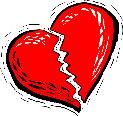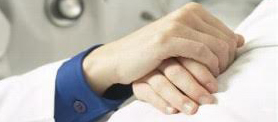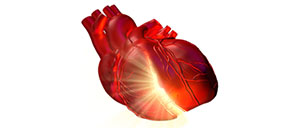Sudden Cardiac Death (SCD)
Overview
Sudden cardiac death (SCD), also known as cardiac arrest, occurs when the heart’s electrical system malfunctions, leading to loss of its pumping function and ultimately death, if untreated. Heart disease is one of the leading causes of death annually in the US, with SCD responsible for on average, half of all heart disease deaths. According to the American Heart Association, SCD claims an estimated 335,000 people each year in the United States, more than stroke, lung cancer, and breast cancer combined.
Definition
Sudden cardiac death is by definition an electrical disturbance, it is not a myocardial infarction (“heart attack”). A “heart attack” occcurs when the arteries of the heart develop a sudden blockage; this can lead to a sudden cardiac death when a cardiac arrhythmia ensues. Ventricular fibrillation (VF), as earlier described, is the leading electrical disturbance responsible for sudden cardiac death. It represents chaotic, disorganized ventricular activity, greater than 300 beats/minute, with essentially no organized ventricular activity or contraction, with resultant hemodynamic collapse. Ultimately, VF leads to “asystole”, or flat-line, with no cardiac electrical activity and death. The primary acute treatment is an electrical cardioversion to save the patient’s life. The majority of ventricular fibrillation victims die before reaching the hospital.
Causes
The causes of sudden cardiac death are varied, but most commonly it is a consequence of coronary artery disease. Patients with a history of a myocardial infarction and structural heart disease are at increased risk of sudden cardiac death. In addition, patients with structural heart disease and heart failure unrelated to any coronary artery disease are also at risk for sudden cardiac death if their heart pumping function, as measured by “ejection fraction” (EF), is sufficiently depressed. Some patients experience a VF arrest complicating an acute “heart attack”. There are many other less common causes of VF, including: Brugada syndrome, long QT syndrome, short QT syndrome, catecholaminergic polymorphic VT syndrome, and idiopathic familial syndromes; as discussed earlier, WPW with uncontrolled heart rates during episodes of atrial fibrillation has a rare, but real possibility of inducing ventricular fibrillation and death.
Predictors
As described in the Ventricular Tachycardia section, a strong predictor of future risk for SCD is a poor cardiac contractile, or pumping, function. “Ejection fraction” is a powerful tool to classify those in the population with a higher-risk of sudden cardiac death. Your physician will typically make an assessment of your heart function that will be reported as a percentage “ejection fraction”. A normal ejection fraction is 55%. This assessment of your LV pumping function can be performed via multiple tests including a heart ultrasound (also known as an echocardiogram), nuclear stress test, cardiac MRI or CT scan, or a MUGA scan. This value is extremely important, and has implications for your long-term medical therapy and outcome. If your “ejection fraction” is below 35%, you are at a higher-risk for sudden cardiac death over the next several years and your physician will recommend the placement of an implantable cardioverter defibrillator (ICD) for primary prevention (that is to prevent future episodes of sudden cardiac death that may arise from an arrhythmia). If you are having recurrent VT or are a survivor of an out-of-hospital sudden cardiac arrest, your physician will also likely recommend you for evaluation for an ICD. An electrophysiology study (EPS) in patients with evidence of structural heart disease with an EF in the range of 40% can be performed to further risk stratify this population (for implantation of ICD) if they have a history of loss of consciousness (syncope) or palpitations. ICD therapy is recommended not only for those patients with structural heart disease and recurrent life-threatening VT, but also empirically (prophylactically) for patients with diminished left ventricular (LV) heart function (typically with EF <40%) to prevent sudden cardiac death. If you are a survivor of an out-of-hospital sudden cardiac arrest, your physician will also likely recommend you for evaluation for an ICD.
Treatment
The primary acute treatment is an early electrical cardioversion (defibrillation) to save the patient’s life. The majority of patients who suffer SCD die before reaching the hospital.
The ultimate preventative strategy for ventricular fibrillation and sudden cardiac death is the control of risk factors that lead to the development of coronary artery disease and subsequent myocardial infarctions. Careful discussion with your physician to optimize management of your diabetes, hypertension, high cholesterol, weight control, and diet is paramount.
In patients with a history of coronary artery disease or heart failure, maintaining optimal medical therapy with b-blockers, ACE-I, aspirin, and statins are critical. This can potentially prevent the progression of heart disease and may improve your ejection fraction over time.
The role of antiarrhythmic medications as discussed in the Ventricular Tachycardia section is limited. These agents are used to reduce episodes of symptomatic or life-threatening ventricular tachycardia. Antiarrhythmic medications can act to slow ventricular muscle conduction and therefore disturb the formation and perpetuation of these reentry loops; or they can reduce the ability of the ventricular muscle tissue to be electrically excited and conduct the rhythm disturbance. Your physician will tailor your medication therapy based on your other history and medications. However, most antiarrhythmic drugs carry a small risk of pro-arrhythmia, that is of causing secondary heart rhythm disturbances; therefore careful consultation with your physician is important. Finally, antiarrhythmic medications will not protect you completely from recurrent episodes of VT and sudden cardiac death.
As discussed earlier, ICD therapy is used both for primary prevention to prevent sudden cardiac death in a subset of the population with significantly diminished left heart function and ejection fractions commonly lower than 35-40%. If a patient survives an out-of-hospital sudden cardiac death, they will commonly also receive an ICD system for secondary prevention of future episodes if there is no identification of a potential reversible cause for the event. The intricacies of the ICDfunction will be discussed in the ICD section, but a short synopsis is in order. An ICD essentially consists of a “generator” with circuitry that allows the interpretation and monitoring of your cardiac rhythm 24 hours a day, seven days a week. This generator is connected to intracardiac leads that are placed into the heart by your physician, typically via one of the upper chest veins. This procedure is performed with both local and general sedation, with an average implantation time ranging from 1-3 hours. The intracardiac leads allow for direct contact with your heart muscle. This is how monitoring of your heart rhythm is accomplished. All current ICDs can function as a pacemaker if needed. If your ICD detects a ventricular tachycardia or fibrillation episode, it will charge its battery and deliver an electrical shock directly into the heart via the intracardiac leads. This is essentially an electrical cardioversion, but performed from inside the heart. The electrical shock will electrically capture all of the heart muscle cells and interrupt the reentry circuit with termination of the tachycardia and resultant normal sinus rhythm.






 Silver Spring Office
Silver Spring Office  DC Office (at Providence Hospital)
DC Office (at Providence Hospital)  Hagerstown Office
Hagerstown Office